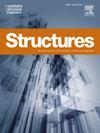Automatic crack detection and segmentation of masonry structure based on deep learning network and edge detection
IF 3.9
2区 工程技术
Q1 ENGINEERING, CIVIL
引用次数: 0
Abstract
Because of high time expense, strong experience dependence and labor intensity, traditional crack detection methods have given way to computer vision-based automatic non-destructive methods, which have been successfully applied to the crack detection of concrete structures. However, the presence of mortar joints between masonry blocks introduces considerable noise in masonry images compared to concrete images, resulting in less efficiency and accuracy of the computer vision-based methods in masonry structures. This study aims to incorporate deep learning network into computer vision to achieve rapid and accurate crack detection in masonry structures. Firstly, the GELAN-Seg network, i.e. the YOLOv9-Seg network without the Auxiliary Supervisory Branch, was improved by adding an edge processing branch to obtain the YOLO-Edge model for higher accuracy of crack segmentation. Then, low-cycle reversed loading experiments were conducted on masonry walls to collect crack images, which were further manually labelled to create a comprehensive dataset of cracks in masonry structures. To assess the effectiveness of the proposed model, the crack segmentation performance of the YOLO-Edge model was compared with GELAN-Seg, YOLOv9-Seg, Mask R-CNN, SOLOv2, YOLACT, ConvNeXt, and Swin Transformer. The results demonstrate that the proposed model can significantly improve crack segmentation accuracy with AP0.5_seg reaching 83.8 %, outperforming other models, e.g. GELAN-Seg (80.4 %), YOLOv9-Seg (81.6 %), Mask R-CNN (64.5 %), ConvNeXt (70.0 %), YOLACT (67.9 %), Swin Transformer (68.5 %) and SOLOv2 (80.7 %). Additionally, the proposed model has smaller parameters, and thus less computation and higher detection speed than other models. These findings confirm the efficacy of the YOLO-Edge model in the crack detection for masonry structures.
求助全文
约1分钟内获得全文
求助全文
来源期刊

Structures
Engineering-Architecture
CiteScore
5.70
自引率
17.10%
发文量
1187
期刊介绍:
Structures aims to publish internationally-leading research across the full breadth of structural engineering. Papers for Structures are particularly welcome in which high-quality research will benefit from wide readership of academics and practitioners such that not only high citation rates but also tangible industrial-related pathways to impact are achieved.
 求助内容:
求助内容: 应助结果提醒方式:
应助结果提醒方式:


